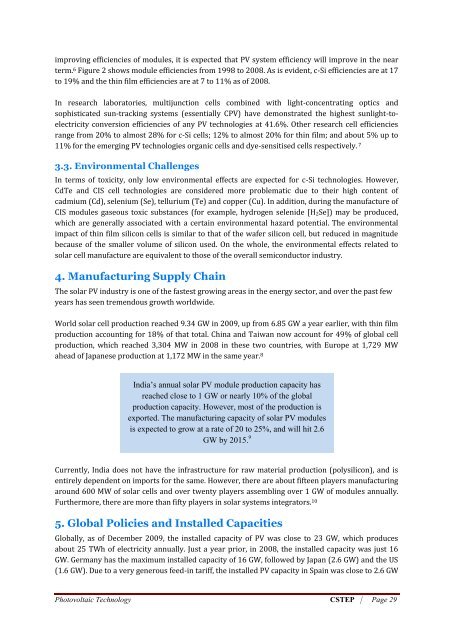Harnessing Solar energy, Options for India
A study on harnessing solar energy options for India was conducted recently by Shakti Sustainable Energy Foundation, Climate works Foundation and SSN foundation. Supporting this study it has been concluded that solar energy can play a big role in providing electricity to rural areas and thus has been included in India’s rural electrification policy. See more at: http://shaktifoundation.in/report/harnessing-solar-energy-options-for-india/
A study on harnessing solar energy options for India was conducted recently by Shakti Sustainable Energy Foundation, Climate works Foundation and SSN foundation. Supporting this study it has been concluded that solar energy can play a big role in providing electricity to rural areas and thus has been included in India’s rural electrification policy. See more at: http://shaktifoundation.in/report/harnessing-solar-energy-options-for-india/
Create successful ePaper yourself
Turn your PDF publications into a flip-book with our unique Google optimized e-Paper software.
improving efficiencies of modules, it is expected that PV system efficiency will improve in the near<br />
term. 6 Figure 2 shows module efficiencies from 1998 to 2008. As is evident, c-Si efficiencies are at 17<br />
to 19% and the thin film efficiencies are at 7 to 11% as of 2008.<br />
In research laboratories, multijunction cells combined with light-concentrating optics and<br />
sophisticated sun-tracking systems (essentially CPV) have demonstrated the highest sunlight-toelectricity<br />
conversion efficiencies of any PV technologies at 41.6%. Other research cell efficiencies<br />
range from 20% to almost 28% <strong>for</strong> c-Si cells; 12% to almost 20% <strong>for</strong> thin film; and about 5% up to<br />
11% <strong>for</strong> the emerging PV technologies organic cells and dye-sensitised cells respectively. 7<br />
3.3. Environmental Challenges<br />
In terms of toxicity, only low environmental effects are expected <strong>for</strong> c-Si technologies. However,<br />
CdTe and CIS cell technologies are considered more problematic due to their high content of<br />
cadmium (Cd), selenium (Se), tellurium (Te) and copper (Cu). In addition, during the manufacture of<br />
CIS modules gaseous toxic substances (<strong>for</strong> example, hydrogen selenide [H 2Se]) may be produced,<br />
which are generally associated with a certain environmental hazard potential. The environmental<br />
impact of thin film silicon cells is similar to that of the wafer silicon cell, but reduced in magnitude<br />
because of the smaller volume of silicon used. On the whole, the environmental effects related to<br />
solar cell manufacture are equivalent to those of the overall semiconductor industry.<br />
4. Manufacturing Supply Chain<br />
The solar PV industry is one of the fastest growing areas in the <strong>energy</strong> sector, and over the past few<br />
years has seen tremendous growth worldwide.<br />
World solar cell production reached 9.34 GW in 2009, up from 6.85 GW a year earlier, with thin film<br />
production accounting <strong>for</strong> 18% of that total. China and Taiwan now account <strong>for</strong> 49% of global cell<br />
production, which reached 3,304 MW in 2008 in these two countries, with Europe at 1,729 MW<br />
ahead of Japanese production at 1,172 MW in the same year. 8<br />
<strong>India</strong>’s annual solar PV module production capacity has<br />
reached close to 1 GW or nearly 10% of the global<br />
production capacity. However, most of the production is<br />
exported. The manufacturing capacity of solar PV modules<br />
is expected to grow at a rate of 20 to 25%, and will hit 2.6<br />
GW by 2015. 9<br />
Currently, <strong>India</strong> does not have the infrastructure <strong>for</strong> raw material production (polysilicon), and is<br />
entirely dependent on imports <strong>for</strong> the same. However, there are about fifteen players manufacturing<br />
around 600 MW of solar cells and over twenty players assembling over 1 GW of modules annually.<br />
Furthermore, there are more than fifty players in solar systems integrators. 10<br />
5. Global Policies and Installed Capacities<br />
Globally, as of December 2009, the installed capacity of PV was close to 23 GW, which produces<br />
about 25 TWh of electricity annually. Just a year prior, in 2008, the installed capacity was just 16<br />
GW. Germany has the maximum installed capacity of 16 GW, followed by Japan (2.6 GW) and the US<br />
(1.6 GW). Due to a very generous feed-in tariff, the installed PV capacity in Spain was close to 2.6 GW<br />
Photovoltaic Technology CSTEP | Page 29

















